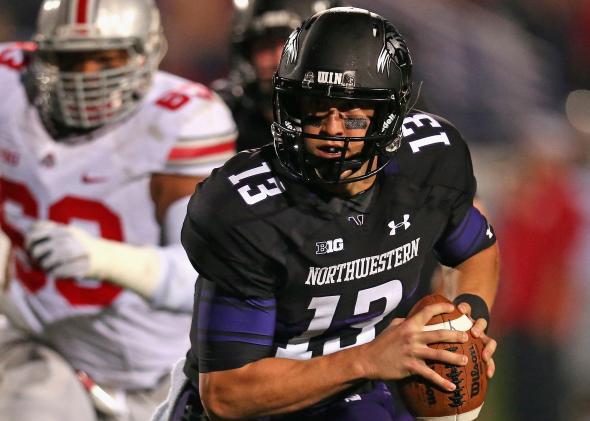This morning, the Northwestern University football players cast their votes on whether to form a union. It’s a potentially historic moment in this history of NCAA sports, given that collective bargaining would officially lay waste to the idea of college athletes as amateurs. The outcome is very much up in the air—we probably won’t know the final result for months. But even if players turn down the union, merely winning the right to vote for one could change college sports for good.
When Northwestern’s players won the right to organize last month, the university promptly began a “vote no” campaign, which the New York Times called “a textbook case of how to aggressively battle a union.” Head football coach Pat Fitzgerald has led the defensive effort, which seems befitting for a former linebacker. A generally beloved figure in the locker room and on campus, he has been meeting with players to “educate” them about the apparently dreadful repercussions of bringing union reps onto campus. Publicly, he’s simply argued that the school can address athletes’ concerns, like better medical care, without collective bargaining.
“I’m incredibly proud of the courageous nature of stepping up,” he said at a press conference. “I just do not believe this is the mechanism to do it. We do not need a third party in between our players and our coaching staff, our athletic department, and our university.”
Translation: “Good effort, guys, but wrong play.”
So far, Fitzgerald seems to have won at least a few of his athletes to his side. Most important among them, perhaps, is quarterback Trevor Siemian. “We filed for employee cards (Jan. 28), but that doesn’t mean a union is the right avenue,” Siemian told reporters. “Especially at Northwestern, where most guys on the team agree we have been treated very, very well. I’m treated here far better than I deserve.”
Meanwhile, Kain Colter, the Northwestern senior and former starting quarterback who has led the organizing drive, has said he’s “confident” the union will win.
So far, only a regional office of the National Labor Relations Board has ruled that Northwestern’s players are employees who can choose to unionize. The national five-member NLRB board in Washington, D.C., is reviewing the university’s appeal, and until it renders a decision, which could take months, the union votes will be impounded, locked away in secret.
Which is why even though today’s big event was on campus in Evanston, Illinois, the real action in this struggle will take place in Washington. The NLRB could put a stake in the unionization movement by overruling its regional office and declaring players are not, in fact, employees. Technically, its ruling would only cover private colleges, because public schools are governed by state labor laws, but state labor boards often take cues from the NLRB.
If it affirms the decision, however, things get interesting.
Should the football team approve a union, Northwestern will likely refuse to bargain with it, which would set up a federal court challenge to settle the question of whether players are actually employees once and for all. But if the players vote against organizing, the unionization movement will still come away with a huge prize. Namely: leverage.
As long as the NLRB says that college football players are employees who can unionize—and given the labor-friendly nature of the board under the Obama administration, there’s a very good chance it will—every single private college in the country with a big-time sports program will have to worry about the threat of an organizing drive down the line. If state labor boards follow the NLRB’s lead, the heat would be on large public universities, too. That alone should push schools to make greater concessions on issues like health, safety, and making sure scholarships cover the full cost of living.
“Simply by filing the representation petition, those young men have improved the lot of all big-time college athletes,” Northeastern University School of Law professor Roger Abrams told me. “Colleges and universities and athletic departments will be much more attuned to making sure their athletes are treated fairly. Because if they’re not treated fairly, the next group can vote [for a union].”
Rather than think of the Northwestern union drive less as a single win-or-lose contest, then, it’s better to consider it as one prong of the multifront legal battle to reform the National Collegiate Athletic Association. The body is already facing two major antitrust suits, one of which has made it past the preliminaries and is scheduled for trial. When basketball star Shabazz Napier told reporters, just minutes after helping the UConn Huskies win a national championship title, that he had gone to bed hungry many nights for lack of cash, the uproar pushed the league to finally allow schools to provide unlimited meals. The NCAA is also moving toward a governance model it says will pave the way for major conference schools to provide more generous scholarships, insurance, and medical care to players.
Even while he railed against the possibility of players unionizing earlier this month, NCAA President Mark Emmert acknowledged that the status quo was untenable. “I think most of the membership recognizes we’re at a fork in the road and some of these things must change and we need to do it rapidly,” he said.
Win or lose in Evanston, if Northwestern’s players can prevail in Washington, the pressure will be greater than ever.
